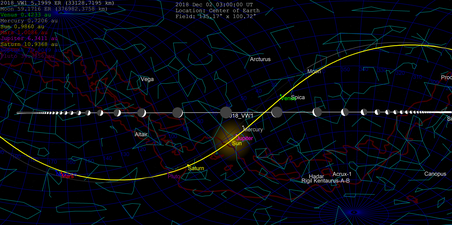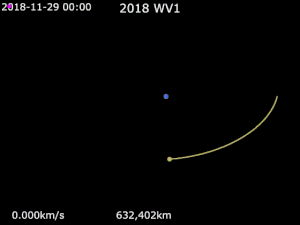2018 WV1
 2018 WV1's flyby trajectory | |
| Discovery [1] | |
|---|---|
| Discovered by | CSS H. Groeller[2][3] |
| Discovery site | Catalina Station |
| Discovery date | 29 November 2018 (first observed only) |
| Designations | |
| 2018 WV1 | |
| ZW0C3A5 | |
| NEO · Apollo [1][4] Earth crosser | |
| Orbital characteristics [4] | |
| Epoch 6 December 2018 (JD 2458458.5) | |
| Uncertainty parameter 2 | |
| Observation arc | 14 days |
| Aphelion | 1.1149 AU |
| Perihelion | 0.9715 AU |
| 1.0432 AU | |
| Eccentricity | 0.0686 |
| 1.065 yr (389 d) | |
| 38.51° | |
| 0° 55m 30s / day | |
| Inclination | 1.9054° |
| 248.51° | |
| 141.37° | |
| Earth MOID | 0.1444 LD (55500 km) |
| Physical characteristics | |
| 4 m (assumed)[5] | |
| 30.145[5] 30.183[4] 30.2[1] | |
2018 WV1 is a very small asteroid and near-Earth object of the Apollo group that passed within 27,000 kilometers (17,000 miles) of the Earth's surface on 2 December 2018.[6][7] It was first observed on 29 November 2018 by Hannes Gröller with the Catalina Sky Survey at Catalina Station on Mount Bigelow, Arizona, in the United States.[1][3]
Orbit
[edit]2018 WV1 orbits the Sun at a distance of 0.97–1.11 AU once every 389 days (semi-major axis of 1.04 AU). Its orbit has an eccentricity of 0.07 and an inclination of 2° with respect to the ecliptic.[4]
As an Apollo asteroid with an orbital period slightly larger than that of the Earth, its orbit is very similar to that of the Earth, indicating that the object could potentially be a piece of lunar ejecta, a fragment of the Moon that was ejected into space when a larger asteroid hit the Moon a long time ago.[7]
2018 flyby
[edit]On 2 December 2018, the asteroid passed about 33,000 km (21,000 mi) from Earth, traveling 5.2 kilometres per second (3.2 mi/s) relative to Earth and briefly reaching apparent magnitude 17.[4] This was the third-closest approach by an asteroid in 2018, and the 70th asteroid of the year that passed within 1 lunar distance of Earth.[6] Its absolute magnitude of 30.1 indicates a diameter between 2.5 and 5.6 metres.[7]
2018 WV1 remained inside the Earth's sphere of influence from 27 November till 7 December 2018.[8] During the flyby, its orbital period changed from 1.13 to 1.06 years.
At the time of its discovery, 2018 WV1 had a 2% chance to hit Earth in early December 2018. The possibility of impact was ruled out soon after, as more data became available.[7]
Other flybys
[edit]2018 WV1 passed within 0.38 AU (57,000,000 km) of Earth in December 2019.[4]
The asteroid, when first discovered, was placed on the Sentry risk table. Further observations refined its orbit enough to remove it from the table on December 3, 2018[9]
Flyby gallery
[edit]-
Its closest approach was between the Earth and Sun, so can't be observed.
-
Animation of 2018 WV1 orbit around Earth
Moon · Earth · 2018 WV1 -
Animation of 2018 WV1 orbit around Sun from 2017 to 2021
Sun · Earth · 2018 WV1
See also
[edit]References
[edit]- ^ a b c d "2018 WV1". Minor Planet Center. Retrieved 7 January 2019.
- ^ "MPEC 2018-W81 : 2018 WV1". Minor Planet Center. 30 November 2018. Retrieved 1 December 2018.
- ^ a b "A small rock discovered this week by our observer Hannes Gröller". Catalina Sky Survey. 1 December 2018. Retrieved 1 December 2018.
- ^ a b c d e f "JPL Horizons System: (2018 WV1)" (2018-12-12 last obs.). Jet Propulsion Laboratory. Retrieved 7 January 2019.
- ^ a b "2018WV1 physical properties". European Space Agency. 1 December 2018. Retrieved 1 December 2018.
- ^ a b "Asteroid 2018 WV1 will flyby Earth at a very close distance of 0.09 LD on December 2, 2018". The Watchers. 30 November 2018. Retrieved 1 December 2018.
- ^ a b c d Byrd, D. (1 December 2018). "Small asteroid to sweep close this weekend". earthsky.org. Retrieved 1 December 2018.
- ^ "Earth's Busy Neighborhood". hohmanntransfer.com. Asteroid/Comet Connection. 1 December 2018. Archived from the original on 2 December 2018. Retrieved 2 December 2018.
- ^ "2018 WV1 -- Earth Impact Risk Summary". JPL. 30 November 2018. Retrieved 1 December 2018.
External links
[edit]- List Of Apollo Minor Planets (by designation), Minor Planet Center
- 2018 WV1 at NeoDyS-2, Near Earth Objects—Dynamic Site
- 2018 WV1 at the JPL Small-Body Database





